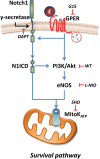Notch1 Mediates Preconditioning Protection Induced by GPER in Normotensive and Hypertensive Female Rat Hearts
- PMID: 29867564
- PMCID: PMC5962667
- DOI: 10.3389/fphys.2018.00521
Notch1 Mediates Preconditioning Protection Induced by GPER in Normotensive and Hypertensive Female Rat Hearts
Abstract
G protein-coupled estrogen receptor (GPER) is an estrogen receptor expressed in the cardiovascular system. G1, a selective GPER ligand, exerts cardiovascular effects through activation of the PI3K-Akt pathway and Notch signaling in normotensive animals. Here, we investigated whether the G1/GPER interaction is involved in the limitation of infarct size, and improvement of post-ischemic contractile function in female spontaneous hypertensive rat (SHR) hearts. In this model, we also studied Notch signaling and key components of survival pathway, namely PI3K-Akt, nitric oxide synthase (NOS) and mitochondrial K+-ATP (MitoKATP) channels. Rat hearts isolated from female SHR underwent 30 min of global, normothermic ischemia and 120 min of reperfusion. G1 (10 nM) alone or specific inhibitors of GPER, PI3K/NOS and MitoKATP channels co-infused with G1, just before I/R, were studied. The involvement of Notch1 was studied by Western blotting. Infarct size and left ventricular pressure were measured. To confirm endothelial-independent G1-induced protection by Notch signaling, H9c2 cells were studied with specific inhibitor, N-[N-(3,5 difluorophenacetyl)-L-alanyl]-S-phenylglycine t-butyl ester (DAPT, 5 μM), of this signaling. Using DAPT, we confirmed the involvement of G1/Notch signaling in limiting infarct size in heart of normotensive animals. In the hypertensive model, G1-induced reduction in infarct size and improvement of cardiac function were prevented by the inhibition of GPER, PI3K/NOS, and MitoKATP channels. The involvement of Notch was confirmed by western blot in the hypertensive model and by the specific inhibitor in the normotensive model and cardiac cell line. Our results suggest that GPERs play a pivotal role in mediating preconditioning cardioprotection in normotensive and hypertensive conditions. The G1-induced protection involves Notch1 and is able to activate the survival pathway in the presence of comorbidity. Several pathological conditions, including hypertension, reduce the efficacy of ischemic conditioning strategies. However, G1-induced protection can result in significant reduction of I/R injury also female in hypertensive animals. Further studies may ascertain the clinical translation of the present results.
Keywords: H9c2; NOS; PI3K/Akt; cardioprotection; isolated rat hearts; preconditioning; reperfusion injury salvage kinases.
Figures







Similar articles
-
Participation of mitochondrial permeability transition pore in the effects of ischemic preconditioning in hypertrophied hearts: role of NO and mitoKATP.Int J Cardiol. 2013 Jun 5;166(1):173-80. doi: 10.1016/j.ijcard.2011.10.103. Epub 2011 Nov 10. Int J Cardiol. 2013. PMID: 22078400
-
GPER mediates cardiotropic effects in spontaneously hypertensive rat hearts.PLoS One. 2013 Aug 9;8(8):e69322. doi: 10.1371/journal.pone.0069322. eCollection 2013. PLoS One. 2013. PMID: 23950890 Free PMC article.
-
Apelin-induced cardioprotection against ischaemia/reperfusion injury: roles of epidermal growth factor and Src.Acta Physiol (Oxf). 2018 Feb;222(2). doi: 10.1111/apha.12924. Epub 2017 Aug 30. Acta Physiol (Oxf). 2018. PMID: 28748611
-
Sevoflurane enhances ethanol-induced cardiac preconditioning through modulation of protein kinase C, mitochondrial KATP channels, and nitric oxide synthase, in guinea pig hearts.Anesth Analg. 2008 Jan;106(1):9-16, table of contents. doi: 10.1213/01.ane.0000297298.93627.36. Anesth Analg. 2008. PMID: 18165545
-
Notch Signaling in Ischemic Damage and Fibrosis: Evidence and Clues from the Heart.Front Pharmacol. 2017 Apr 5;8:187. doi: 10.3389/fphar.2017.00187. eCollection 2017. Front Pharmacol. 2017. PMID: 28424623 Free PMC article. Review.
Cited by
-
Comparative G-Protein-Coupled Estrogen Receptor (GPER) Systems in Diabetic and Cancer Conditions: A Review.Molecules. 2022 Dec 15;27(24):8943. doi: 10.3390/molecules27248943. Molecules. 2022. PMID: 36558071 Free PMC article. Review.
-
Improving translational research in sex-specific effects of comorbidities and risk factors in ischaemic heart disease and cardioprotection: position paper and recommendations of the ESC Working Group on Cellular Biology of the Heart.Cardiovasc Res. 2021 Jan 21;117(2):367-385. doi: 10.1093/cvr/cvaa155. Cardiovasc Res. 2021. PMID: 32484892 Free PMC article. Review.
-
The Use of Nutraceuticals to Counteract Atherosclerosis: The Role of the Notch Pathway.Oxid Med Cell Longev. 2019 May 2;2019:5470470. doi: 10.1155/2019/5470470. eCollection 2019. Oxid Med Cell Longev. 2019. PMID: 31915510 Free PMC article. Review.
-
Cardiac and Metabolic Impact of Functional Foods with Antioxidant Properties Based on Whey Derived Proteins Enriched with Hemp Seed Oil.Antioxidants (Basel). 2020 Oct 30;9(11):1066. doi: 10.3390/antiox9111066. Antioxidants (Basel). 2020. PMID: 33143213 Free PMC article.
-
Retracted Article: Knockdown of TUG1 aggravates hypoxia-induced myocardial cell injury via regulation of miR-144-3p/Notch1.RSC Adv. 2019 Jul 25;9(40):22931-22941. doi: 10.1039/c9ra01311c. eCollection 2019 Jul 23. RSC Adv. 2019. Retraction in: RSC Adv. 2021 Jan 26;11(9):5026. doi: 10.1039/d1ra90039k. PMID: 35514492 Free PMC article. Retracted.
References
LinkOut - more resources
Full Text Sources
Other Literature Sources

